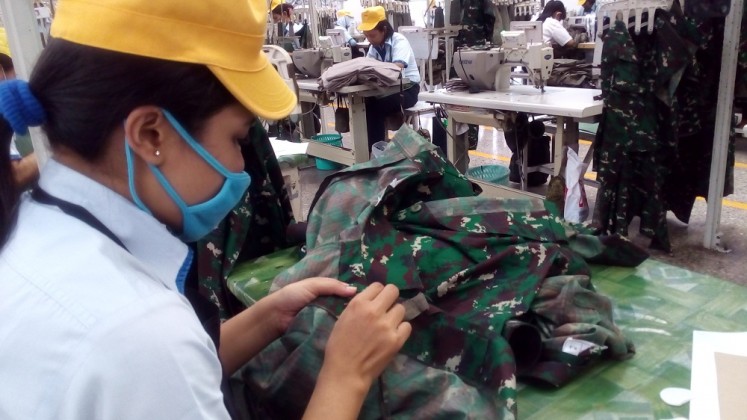Popular Reads
Top Results
Can't find what you're looking for?
View all search resultsPopular Reads
Top Results
Can't find what you're looking for?
View all search resultsSeeds of biofuel
Guzzling greener gaz: Resourceful residents of Central Java’s Bantul try out biodiesel made of nyamplung (Calophyllum inophyllum) on a 1,000 kilometer van test drive
Change text size
Gift Premium Articles
to Anyone
G
span class="caption">Guzzling greener gaz: Resourceful residents of Central Java’s Bantul try out biodiesel made of nyamplung (Calophyllum inophyllum) on a 1,000 kilometer van test drive.
Like many small things, the seeds of the coastal plant nyamplung are often overlooked — until someone enterprising realizes their value.
In the case of nyamplung (Calophyllum inophyllum), that enterprising someone was Wahyudi Anggoro Hadi, a resourceful youth in Pandes, in Bantul regency.
For a long time, this plant, which thrives in tropical areas, was used only as firewood, although in the past, people lit their homes by burn its dried seeds, which have a high oil content.
Nyamplung seeds have an oil output rate of 50–73 percent, which is far higher than that of castor seeds, at 40–60 percent, or oil palm kernels, at 46–54 percent.
But now Yudi, as he is usually called, has harness the seeds’ oil to make an alternative fuel.
“After having run dozens of experiments since July 2008, we can now process the seeds into ready-for-use biodiesel fuel,” he said.
The first step in processing the seeds is to crush the nyamplung fruit, which have hard shells, using a machine. The shells are then separated from their seeds by hand.
“More than 20 villagers, mostly women, gather the seeds each day, and they make Rp 150 per kilogram as extra income,” said Yudi, who graduated in pharmacy from Gadjah Mada University in Yogyakarta.
“This is casual work so we do it at home,” said Ranem. The 70-year-old grandmother said she was delighted to be part of the biodiesel fuel cottage industry, saying that she could do the work while cooking and caring for her four grandchildren, making between Rp 10,000 (US$1) and Rp 15,000 daily.
The next step is to extract the oil from the seeds using a press machine. To produce clear biodiesel fuel, the oil is chemically treated and left to settle for 24 hours. After that, the oil is strained through a fine sieve to separate it from solids and make it ready for use.
Sideline business: Housewives in the Pandes village take daily side jobs of sorting out and peeling nyamplung seeds.
Now the village of Pandes has a daily capacity of 600–800 liters of biodiesel fuel. To make 1 liter of biodiesel fuel requires 2.5 kilograms of seeds, meaning the village everyday processes between 1,500 kilograms and 2,000 kilograms.
“We can’t handle anymore than 800 liters a day,” Yudi said. “Market demand is higher, but with our limitations we can’t yet meet it.”
In the middle of this industry, Yudi is continuing to experiment with production technology to design the most effective method. After all, as a pioneer, he has no nyamplung-seed processing manual to guide him.
“Unlike castor bean processing, with its purchasable standard technology for oil extraction, nyamplung seeds still require experimentation,” he explained.
Selling the biodiesel fuel, Yudi said, is easily done, and several companies have become regular customers.
“We’re not yet capable of mass production, though. For now, the most important thing is to make a fair profit, open up job opportunities and continue to seek the most efficient production technique,” he said, adding that is economical to use biodiesel fuel, as, at Rp 4,000 a liter, it is cheaper than gasoline.
As a tropical plant, nyamplung is abundantly available along coastal areas such as those in Kebumen regency, Central Java.
“For the next 10 years, nyamplung trees will remain plentiful, even without us trying to farm it,”
Yudi said.
The use of nyamplung, Yudi added, is its commercial value for locals, as the coastal trees have to date mostly been left unexploited. Now residents can collect nyamplung fruit, which are bought at
Rp 1,000 per kilogram.
“We need at least 2 tons daily. When we visited Kebumen, some of the residents who used to earn a meager income got sufficient money from the part-time work to pay for their children to go to school,” he said.
Trials on the use of the Pandes biodiesel fuel began using cars, with three test drives; the first went 375 kilometers, the second 1,100 kilometers and the most recent one, 1,000 kilometers.
“In the first trial, the car kept stalling because the biodiesel fuel combustion residues were still heavy,” said test driver Arief Hidayatullah.
But, after another purification attempt using the bubble wash method, no such problems emerged for the second and third test drives. This method cleanses the fuel and removes any impurities by spraying it with steam.
Exhaust emission tests show that this biodiesel fuel’s viscosity is 48 percent, lower than that of diesel fuel now in use, which is 54 percent, and far below the government’s maximum standard of 70 percent.
Arief claimed that, during his test drives, he had no troubles, saying the power and acceleration produced were equal to those generated by ordinary diesel fuel. He said his next step is to dismantle the car engine to find out what kind of effects the biodiesel fuel had on it.
“We haven’t yet calculated whether the use of biodiesel fuel saves more energy or not,” he added.
To establish the benefits of the nyamplung biodiesel fuel, the Pandes youths are preparing for a 10,000 kilometer test drive — as far as Kalimantan — should they find any funding.
“Fund for this test drive is proving hard to get,” Yudi said. “So far we’ve always shared the cost of doing anything in this project.”
The 10,000-kilometer test drive will require at least three cars: for the trial itself, for the test equipment and for the car crew.
Work of the day: Women pick up sacks of nyamplung seeds for sorting process prior to biodiesel production.
“We hope some sponsors will be interested in this effort because we just don’t have enough money to buy the three cars,” said Yudi.
The building of the biodiesel fuel installation in Pandes was made possible by contributions by several affluent residents.
“Our installation and the 150 tons of nyamplung available now cost more than Rp 500 million,” Yudi
revealed.
Another benefit of the fuel is that any waste left over after processing can also be used.
“The fruit peel is combined with cow dung to make compost,” said Yudi. Fruit residue after extraction can also be turned into briquettes — a small fuel brick made from 1 kilogram of residue can burn for 12 hours at a stretch.
For the moment, however, most nyamplung fruit residue is used as extra cattle feed, even though its protein content has not yet been determined by laboratory tests.
“So even the waste is never wasted,” said Yudi.
His dream is to be able to mass-produce the biodiesel fuel to meet demand, on the grounds that this fuel is both environmentally friendly and relatively inexpensive.
“This will hopefully also inspire the birth of other alternative bioenergy fuels in Indonesia. We have various kinds of vegetation that are a potential energy source right here,” Yudi said.
Despite marketing his fuel, Yudi and his peers have not yet considered seeking to patent it because the most efficient production technology is not yet created and biodiesel fuel materials are widespread.
Plus, he has a more noble intent.
“The patent belongs to God for creating diverse plants as energy sources in Indonesia, which can be used by everybody in the country,” he said.
— Photos by Tarko Sudiarno












